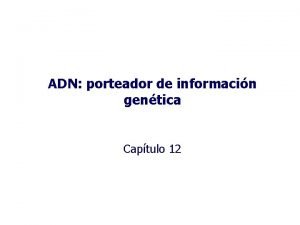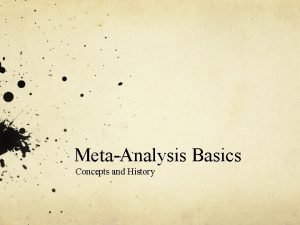Coffee drinking and leukocyte telomere length A metaanalysis

- Slides: 1

Coffee drinking and leukocyte telomere length: A meta-analysis Bella Kotlyar 1, 2, Rashmi Sinha 1, Neal D. Freedman 1, Erikka Loftfield 1 1 Division OBJECTIVE To explore the association between leukocyte telomere length and overall coffee consumption of Cancer Epidemiology and Genetics, National Cancer Institute, Rockville, MD 2 Yale School of Public Health, New Haven, CT Table 2: Participant characteristics by tertile of coffee intake Higher BACKGROUND 51% of Americans over the age of 20 drink coffee every day Coffee consumption has been associated with lower risk of… METHODS § Study population - Prostate: 1, 574 non-Hispanic white men, aged 55 -74, selected for RESULTS Higher Coffee Lower Table 3: Heavier coffee consumption is associated with higher odds of longer telomere length previously conducted case-control studies nested in the PLCO Cancer Screening Trial Gastric: 238 participants, aged 55 -74, selected for previously conducted case-control studies nested in the PLCO Cancer Screening Trial § § Assessment of coffee intake: self-administered FFQ § Statistical analysis: multivariable unconditional logistic regression models used to estimate odds ratios (OR) and 95% confidence intervals (CI) for categorized levels of coffee consumption - Subgroup analyses - Tests for heterogeneity and p-trends Laboratory analysis: quantitative real-time polymerase chain reaction (PCR)-based assay used to measure relative telomere length CONCLUSIONS § Coffee drinking appears to be directly associated with likelihood of having Endometrial cancer Liver cancer Type 2 diabetes Parkinson’s disease Mortality relatively long telomere length among the prostate case-control study sample. Table 4: Odds ratios for heavy vs. no coffee intake and longer telomere length by participant characteristics OR (95% CI) 1. 68 (1. 12, 2. 51) Overall Case/Control Status Case Control Sex Male Age group (y) ≤ 59 1. 45 (0. 76, 2. 77) 1. 87 (1. 11, 3. 15) 1. 64 (1. 10, 2. 45) 1. 33 (0. 62, 2. 87) 1. 25 (0. 65, 2. 40) 3. 24 (1. 29, 8. 14) 60 to 64 ≥ 65 BMI category (kg/m 2) <25 Telomere length has been associated with diseases such as type 2 diabetes and several types of cancers, but… … it’s complicated. Some studies show shorter telomeres associated with increased risk for disease, and some show the opposite. § 25 to 30 ≥ 30 1. 86 (0. 84, 4. 11) 1. 55 (0. 87, 2. 77) 1. 40 (0. 60, 3. 23) Smoking status Never Former Current 1. 29 (0. 75, 2. 21) 2. 15 (1. 05, 4. 37) 0. 75 (0. 08, 7. 46) Alcohol consumption (drinks/day) None <1 1 to 3 ≥ 3 Physical activity (hours/week) None <1 1 to 2 ≥ 3 1. 19 (0. 54, 2. 64) 2. 17 (1. 20, 3. 93) 1. 51 (0. 27, 8. 55) 0. 96 (0. 25, 3. 67) 0. 92 (0. 29, 2. 93) 1. 20 (0. 43, 3. 40) 1. 98 (0. 91, 4. 34) 1. 99 (1. 06, 3. 75) 0. 25 0. 5 1 2. 5 5 10 A statistically significant association was not found within the gastric case -control study. This study sample may not be sufficiently powered to detect an association. DISCUSSION Our overall OR findings are consistent with those in the Nurses’ Health Study population (Liu, Crous-Bou et al. , 2016) - However, they found a significant p-trend of 0. 02, vs. our 0. 24. - Our results may change as we add data from the remaining studies. Strengths - Consideration of multiple study populations for analysis of association - Detailed adjustment for smoking and other potential confounders - Blood samples used to measure telomere length were drawn at randomization of PLCO when participants were cancer-free Limitations - Cross-sectional design - Small sample size of gastric study - Modest statistical power to test interactions NEXT STEPS § We are awaiting data from the following already-approved case-control studies: Non Hodgkin's lymphoma, lung and renal cancer, and glioma. § As a secondary objective, we plan to observe if/how healthy lifestyle (i. e. high Healthy Eating Index score, normal BMI, more physical activity) modify the relationship between leukocyte telomere length and overall coffee consumption. ACKNOWLEDGEMENTS Thank you to The Office of Intramural Training & Education, DCEG, NCI.

